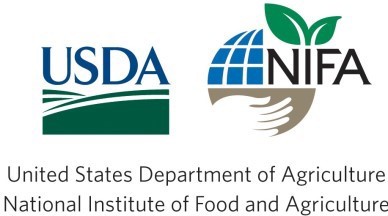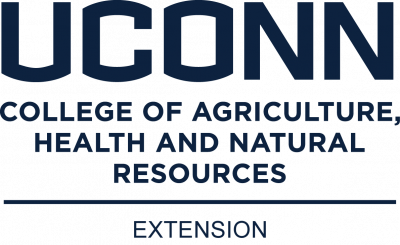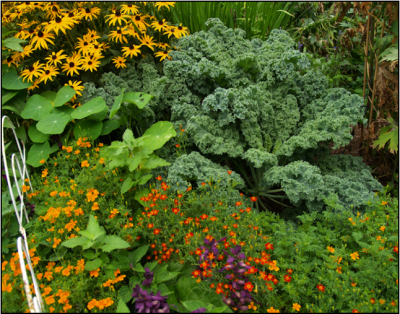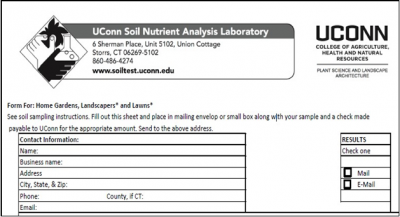Mary Concklin, Extension Educator Emeritus - Fruit Production & IPM
Victoria Wallace, Extension Educator - Sustainable Landscapes
Alyssa Siegel-Miles, Research Technician
Traditional landscapes are comprised of separate plant beds and lawn, often with a utilitarian layout, without consideration for inputs of fertilizer, water, chemicals or labor. Vegetable gardens are maintained separate from ornamental beds, as well as fruit plantings. Herbs may be included as part of the vegetable garden, mixed within the ornamental garden, or separated in a dedicated space.
Sustainable landscapes differ from traditional landscapes. They are designed to conserve water, feed soil organisms, provide food for beneficial insects, and reduce inputs of fertilizer and chemicals, both organic and non-organic. Edible landscapes consist of a wide variety of plants with edible fruit, flowers, stems, and/or leaves.
What is a Sustainable Edible Landscape?
Sustainable edible landscapes have no delineation lines between beds - ornamental plants, vegetables, fruits and herbs are grown together. Edibles add color, scent, texture, shape, and variations in plant height and size to the landscape, as well as attract many pollinators and beneficial insects. This increase in beneficial insects may result in a reduction in the need for pesticide use.
Edible landscapes are wildlife friendly, providing sustenance for birds, butterflies, bees, and mammals. When planning an edible landscape, unless bird or deer deterrents are used, expect to share the garden with wildlife.
These landscapes are constantly changing as annual edible plants are harvested - as plants are removed and the areas are replanted to cover crops or other edibles.
Sustainable Edible Landscape Considerations
Many of our ornamental and edible plants perform multiple functions in the landscape: provide an aesthetically pleasing view, supply food for people and wildlife, support beneficial insects, butterflies and birds, deter insect pests, attract insect pests away from specific plants, provide shade, food, and shelter for insects, and support an environmentally sustainable landscape.
A number of factors must be considered when developing a sustainable, edible landscapes.
Soil pH: Soil pH requirements vary between species of ornamentals, fruits, vegetables and herbs. When incorporating and mixing such variety in the same garden bed, knowing the pH requirements is important. Although the majority will grow and thrive with a soil pH of 6.0-7.0, acid loving plants, such as blueberry, cranberry (Vaccinium macrocarpon), azalea, and rhododendron, will need to be planted together in a lower soil pH in order to thrive.
Organic matter: Organic matter supplies valuable nutrients to plants and provides a healthy environment for soil microbes. Organic matter increases with the addition of compost, and as plant material and mulch break down in the garden over time. Understanding the percent organic matter in the soil is important, because not all plants thrive in high organic matter soils. For example, in high organic matter soils, grapes will put on excessive growth, to the detriment of fruit.
Sunlight: Sunlight requirements of plants also vary. Most vegetables and fruit prefer full sun conditions (minimum of eight hours of sun), although currants, alpine strawberries (Fragaria vesca) and highbush cranberry (Viburnum opulus var. americana) will do well in partial shade conditions. Most herbs prefer full sun, although chervil and parsley will also grow well in partial shade. Ornamentals run the gamut of preferring full sun to full shade. It is acceptable to plant shade-loving plants on the shady side of buildings or under larger shrubs or trees as long as they do not excessively compete for available water and nutrients.
Water: Water requirements vary. All plants require water during establishment and most require one to two inches per week during the peak growing season. Group plants according to their water requirements to maximize water efficiency and support plant health. Plants that favor more water will continue to grow, but may require more frequent watering than drought loving plants. Once established, drought tolerant plants will continue to grow during extended dry periods in the growing season, but may require less watering. Avoid overhead irrigation, if possible, to reduce leaf wetness and limit potential plant disease issues. If overhead irrigation is the only option, be sure to water early in the morning to allow plants to dry quickly.
Nutrient requirements: Some vegetables require more fertilizer to support flower or fruit production, such as asparagus, tomatoes, and members of the brassica family, while members of the root family (e.g., carrots, onion, potato, squash) typically require less fertilizer. Group vegetables that require the same level of nitrogen fertilization together to maintain optimum plant health. Be aware that mature fruit trees, as well as fruiting ornamental shrubs and trees, remove a substantial quantity of nutrients from the soil, especially nitrogen and potassium, as the plants grow and fruit develops. It is important to regularly complete a soil test to determine the fertility needs of the soil. Soil test kits are available from the UConn Soil Lab (soiltest.uconn.edu).
Pollination: Be aware of the pollination requirements of all plants in the edible garden, especially plants that require cross-pollination. Most fruit trees require two varieties for cross-pollination. Berry crops are self-fruitful (self-pollinated), although for blueberries, black currants, and elderberries, planting two varieties will increase the fruit set and size. Most fruiting vegetables do not need a second variety to produce a crop.
Frost: In the spring, flowering plants that grow low to the ground (e.g., strawberries) are often susceptible to frost damage. Given a choice, avoid planting early in the season in low areas when temperatures are cool, as cool soil temperatures do not encourage root growth. If possible, delay planting annuals until after the last spring frost date. Planting after soils are consistently warm favors establishment success and encourages favorable plant growth.
Planting choices: Plants in a sustainable edible landscape can be planted in the ground, in containers placed within the garden, or in hanging baskets. Containers are excellent for plants that would be considered “movers,” such as mints (which spread via aggressive roots), and plants that self-seed, such as black eyed Susans and cleome, so they don’t overrun the landscape. To avoid self-seeding, deadhead the plant before they set seeds.
Plant support: Grapes, brambles, peas, scarlet runner beans, and tomatoes are edible plants that need a support system, such as a stake, a trellis, an arbor or other type of structure. Squash, melons, and cucumbers can be held up on supports to reduce their horizontal space requirements. This also adds height, structure, and shape to the landscape.
Seasonality: Annual vegetable crops can be categorized as either cool or warm season, based on the climate that they prefer. Cool season crops (e.g., broccoli, spinach, peas, radishes, Brussels sprouts, beets, and kale) produce a better quality or quantity of edible produce in the spring and fall when temperatures are cooler. Although these vegetables can be grown in the hot summer months, they require more maintenance, as they tend to bolt quickly in the heat. Once these crops are harvested, warm season annual crops (e.g., eggplant, tomatoes, cucumbers, melons) can be substituted or planted in their place in the landscape.
Mature plant size: Mature plant size must always be considered when planning in the landscape. Although over-crowded annuals can be removed, herbaceous perennials, trees and shrubs demand a long-term investment and need to be properly spaced when planted. Plant annuals between growing perennials to fill voids until perennial crops have grown to their mature size. For perennial gardens that incorporate edible plants with ornamental plants, adequate spacing will reduce disease incidence and the need for improper pruning to maintain plants in a cramped space. When incorporating fruit trees into the landscape, both semi-dwarf and standard-sized fruit trees provide shade along a patio, but be mindful of maturing and dropped fruit where activity may occur.
Root systems: In a landscape setting, the shallow root systems of some perennial plants may compete with understory plants. Berry crops (excluding grapes), full-dwarf fruit trees, and many ornamentals are shallow-rooted plants. Other perennial crops planted under those may not thrive.
Groundcovers: In addition to ornamental ground covers, many fruits, vegetables and herbs may be used as groundcovers. Examples include strawberries, low-bush blueberries, cranberries, lettuce, rhubarb, curly parsley, thyme, and mints (mints tend to spread beyond their designated area – be prepared). Ajuga, a low growing ornamental with attractive purple leaf varieties, bi-color varieties, and bronze leaf varieties, can be a colorful groundcover, but it can be invasive and creep into lawn areas.
Foundation plants, backbone and landscape focal points: Focal point plants are interesting, different, often command attention and intentionally draw the eye. Focal points can also be physical structures that support plants or plants themselves. A focal point can be created by planting a group of several small to medium-sized plants or one large plant. Backbone plants are those that support the landscape, while foundation plants are those that form the building foundation cover. Plants that serve well as ornamental landscape focal points, backbones, and foundations include hollies, winterberry, viburnums, and dogwoods. Harry Lauder’s walking stick is an interesting focal point plant. Many fruit plants work as a focal point, including those that are espaliered. Fruit trees and tall shrubs can serve as both backbone plants and foundation plants, such as highbush blueberries, hardy fig, and highbush cranberries. In addition to providing food, many of these plants provide excellent color in the fall or early winter season interest. Blueberry is a beautiful focal point plant in the fall when the leaves turn bright red. Various parts of ornamental, fruit, vegetable or herb plants are edible, including flowers, leaves, roots, seeds, stems, and fruit.

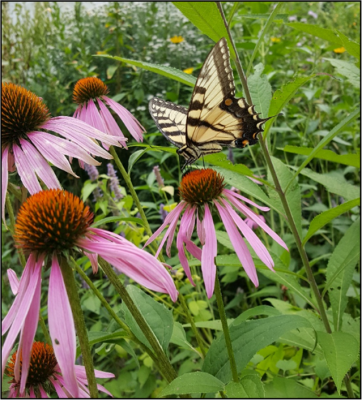
Flowers: Many ornamental plants have edible flowers, including coreopsis, lily, magnolia, rose, nasturtium, marigold, pansy, coneflower, carnation, calendula, and bee balm. Some flowers that are edible, but do not have a good flavor, such as snapdragon, are often used for garnish, even if not consumed. Squash flowers are edible as well as used as a garnish. Lavender flowers are edible. Broccoli is actually flower buds. Garlic scapes (the flower stalk and flower bud of garlic) are roasted and used in recipes the same way as garlic bulbs.
Seeds: Pumpkin and sunflower seeds are edible.
Stems: Rhubarb stems are the edible portion, while the leaves are actually poisonous. Celery, broccoli, ginger root and onions are other examples of plants that have edible stems.
Leaves: Lettuce, Swiss chard, and kale are plants whose main edible parts are the leaves, while some plants, such as beets, are best known for their edible roots but also have edible leaves.
Roots: Carrots, parsnips, and beets are plants with edible roots.
Adding color with edibles is an added bonus for landscape interest and diversity. Swiss chard comes in multi colors; rhubarb has red stems and large deep-green leaves; blueberry leaves turn red in the fall; and beet foliage has maroon veins. Lettuce varieties include not only the usual green, but also red and various color combinations. Eggplant is light to dark purple, white, and black, while ornamental cabbage is colorful with white, maroon and purple coloring. Herbs add color with green and purple basil varieties, purple and white lavender varieties, as well as different textures (e.g., rosemary).
Plants and Natural Enemies
Edible sustainable landscapes, with a wide range of species, plant height, color, scent, flowers, and pests, are attractive to natural enemies of plant pests. Beneficial insects and other animals are not expected to eliminate a pest population; instead, they help to maintain a natural balance. Members of the Umbelliferae family (parsley, cilantro, dill), Compositae family (sunflower, lettuce, cosmos), Lamiaceae family (mints), and Legumes (peas, clover, hairy vetch) are excellent at luring beneficials to the landscape, where they feed on plant pests.
Be aware of beneficial insects’ and mites’ requirements for breeding, shelter, and food sources when insect pest populations are not abundant. An abundance of flowering plants that have different flowering seasons is needed to provide a steady food source for beneficials when insect pests are not available. Many beneficial insects feed on nectar and pollen during these times. Providing alternative food sources throughout the growing season will help to ensure they do not leave to seek insect pests elsewhere.
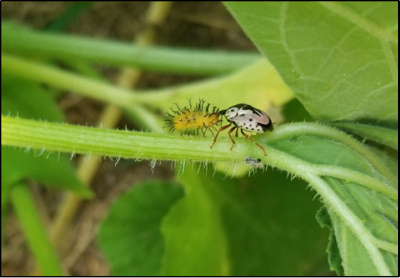
Not only is a wide variety of flowering plants important, varying plant heights and flowers of different sizes are also needed. Small beneficial insects can drown in large flowers and prefer small flowers.
Butterflies prefer small flowers such as strawflowers, yarrow, and fennel, as well as flowers of carrots.
Ground beetles, which feed on a wide range of insects, including aphids, breed under low-growing plants and find shelter under herbs, such as mint and rosemary. Lacewings prefer a shady location to lay their eggs, which can be found on the undersides of foliage and on fruit and vegetables.
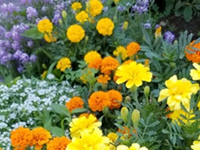
Providing accessible water sources for drinking and breeding is important for encouraging populations of beneficials in landscapes. Whether the landscape has a water feature, a birdbath, or other source of water, it is important that stagnant water be changed regularly.
Certain plants attract specific beneficials. Sunflowers are attractive to Assassin bugs, which are generalist beneficials that feed on a wide range of insects; buckwheat, an edible cover crop, attracts Tachinid flies, which attack and parasitize many insects, including beetles and caterpillars. A wide variety of flowers is attractive to Lacewings, generalist beneficial insects, including cosmos, coreopsis, and Queen Anne’s lace.
Companion planting places a known beneficial loving plant next to, or near, a plant known to be attacked by specific pests. For example, hibiscus and roses are known to be Japanese beetle magnets - the beetles can quickly overwhelm and devour them. Garlic and chives repel Japanese beetles, so plant them near or under hibiscus and rose plants. Onions, chives, basil, and mints emit scents that are loved by people but repel some insect pests, such as aphids, brassica pests, and whiteflies. Cabbageworms attack vegetables in the brassica family. Geraniums repel cabbageworms and add beautiful color to the landscape at the same time. Marigolds are attractive to hoverflies, which feed on aphids; they are also known to deter nematodes, which are pests of many vegetable root crops, when planted near or around gardens.
Trap cropping is used to attract an insect pest away from the preferred crop. The trap crop is then removed and destroyed or targeted with a pesticide that will not negatively affect beneficial insect and nearby plants. If the landscape has plants that are annually attacked by caterpillars, plant nasturtiums, which are a caterpillar trap crop. If slugs are feeding on strawberry fruit or other high value crops, plant chervil around the strawberries. Chervil will attract slugs and keep them away from the desired fruit. Japanese beetles prefer white geraniums, so plant them around hibiscus and roses. Trap cropping does not always eliminate the undesirable pest populations, but does reduce the severity of feeding damage to the preferred crop and provides a chance for the beneficial population to keep it in check.
Additional Tips
Other tips for developing a sustainable edible landscape:
- Mulch is important for soil moisture retention. Keeping desired edible crops, such as strawberries, off the soil will reduce slug damage and fruit rot.
- Practice good sanitation. Remove senescing or rotting leaves that harbor pests or encourage disease.
- Berries will attract a multitude of birds.
- Some plants are considered undesired weeds by some, but may be considered a beautiful flower and pollinator source to others.
- Seasonal changes will occur in the garden throughout the year, due to harvesting practices, different time of emergence and flowering of perennials, removal and replacement of annuals, and foliage color transformations.

A stand of buckwheat cover crop. Photo by Victoria Wallace.
- Plant disease and insect resistant species or cultivars when applicable, as well as plants with natural defenses against pests (e.g., hairy or succulent foliage, milky sap), such as herbs or lavender.
- Use of cover crops, where applicable, supports soil health. Benefits include penetrating and loosening compacted soil, reducing soil erosion, adding organic matter to the soil, and suppressing weeds. Cover crops are not only beneficial to the soil; they also attract many beneficial insects and often are edible (e.g., wheat, buckwheat, and daikon radish). Cover crops can be incorporated in early fall when annuals are removed to stabilize soil during the winter months, as well as during the growing season in larger garden areas or in small pockets in the edible landscape. They must be cut down and worked into the soil before they go to seed, or they may become a weed.
Table 1. Recommended Plants for an Edible Landscape:
| Plant | Edible part | Beneficial purpose/
Uses in an edible landscape |
| Basil | Leaves | Color, repels some insect pests |
| Beet | Leaves, roots | Color |
| Blueberry
(highbush and lowbush) |
Fruit | Color, backbone and foundation plant (highbush), groundcover (lowbush) |
| Broccoli | Florets, stalk | Cool season vegetable |
| Carrot | Roots | Attracts butterflies |
| Celery | All | Adds height |
| Chervil | Leaves, roots | Slug trap crop (plant next to strawberries); attracts beneficials |
| Chive | All | Repels some insect pests (e.g., Japanese beetles) |
| Cilantro | All | Attracts beneficials |
| Clover | Aboveground parts (flowers, leaves, stems, and seeds) | Attracts beneficials |
| Coreopsis | Flowers | Attracts beneficials (e.g., lacewings) |
| Cosmos | Flowers | Attracts beneficials |
| Cover crops (including wheat, buckwheat, daikon radish, others) | Species specific | Penetrates and loosens compacted soil, attracts beneficials, reduces soil erosion, adds organic matter to the soil, suppresses weeds |
| Cranberry | Fruit | Groundcover, backbone and foundation plant (highbush) |
| Dill | Leaves, stems, flowers, seeds | Attracts beneficials |
| Dogwood | Fruit | Groundcover |
| Eggplant | Fruit | Color |
| Fennel | All | Attracts butterflies |
| Garlic | Scapes (flower stalk and flower buds), bulbs | Repels Japanese beetles |
| Geraniums | Leaves, flowers | Color, repels cabbage worms |
| Ginger Root | Leaves, stems, roots | Attractive foliage |
| Grape | Leaves, fruit | Focal point |
| Hardy Fig | Fruit | Backbone and foundation plant |
| Harry Lauder’s Walking Stick | Nut | Focal point |
| Hollies | Focal point, backbone, and foundation plant | |
| Kale | Leaves, stems | Texture, color |
| Lavender | Flowers | Texture, color |
| Lettuce | Leaves | Groundcover, color, attracts beneficials |
| Marigold | Leaves, petals | Attracts beneficials, deter nematodes |
| Mints | Leaves, stems | Groundcover, attracts beneficials, provides shelter for beneficial ground beetle, repels some insect pests |
| Nasturtium | All | Caterpillar trap plant |
| Onion | Bulbs, stems | Repels some insect pests |
| Ornamental cabbage | Leaves | Color |
| Ornamental plants, including: lily, magnolia, rose, pansy, coneflower, carnation, calendula, bee balm | Flowers | Color |
| Parsley | Leaves, roots, stems, seeds | Groundcover, attracts beneficials, garnish |
| Parsnip | Roots | Attracts butterflies |
| Pea | All parts (leaves, flowers, roots, stems, shoots, seeds) | Attracts beneficials |
| Pumpkin | Seeds, fruit | |
| Queen Anne’s lace | Flowers, seeds (leaves are poisonous if eaten in large quantities. Some look-alikes are toxic, so correct ID is critical). | Attracts beneficials (e.g., lacewings) |
| Rhubarb | Stems | Groundcover, color |
| Rosemary | Leaves, flowers | Texture, groundcover, provides shelter for beneficial ground beetle |
| Snapdragon | Flowers | Garnish |
| Squash | Flowers | Garnish |
| Strawberry | Fruit | Groundcover |
| Strawflower | Flower | Attracts butterflies |
| Sunflower | All parts (leaves, flowers, roots, stems, shoots, seeds) | Attracts beneficials (e.g., assassin bug) |
| Swiss chard | Leaves, stems | Color, texture |
| Thyme | Leaves, flowers | Groundcover |
| Yarrow | All parts | Attracts butterflies |
Questions? Contact:
Vickie Wallace
UConn Extension
Extension Educator
Sustainable Turf and Landscape
Phone: (860) 885-2826
Email: victoria.wallace@uconn.edu
Web: ipm.uconn.edu/school
The information in this document is for educational purposes only. The recommendations contained are based on the best available knowledge at the time of publication. Any reference to commercial products, trade or brand names is for information only, and no endorsement or approval is intended. UConn Extension does not guarantee or warrant the standard of any product referenced or imply approval of the product to the exclusion of others, which also may be available. The University of Connecticut, UConn Extension, College of Agriculture, Health and Natural Resources is an equal opportunity program provider and employer. UConn Extension is committed to providing equal access and full participation for individuals with disabilities within all our programs and activities. Visit s.uconn.edu/accessibility for more resources
©UConn Extension. All rights reserved.
